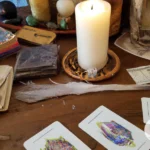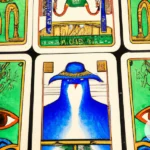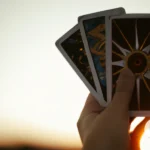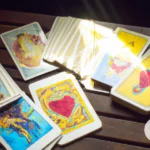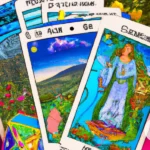Throughout human history, people have sought ways of understanding the realm of the unknown and mysterious. One of the oldest methods used for divination is the use of oracle cards. These decks of cards have been created and used for centuries to gain insight into the future, guidance for decision-making, and spiritual reflection. Though the concept of oracle cards may differ from culture to culture, their purpose remains the same: to provide a means of communication with the divine. In this article, we will delve into the fascinating history and evolution of popular oracle card decks, exploring their origins, developments, and current popularity in the spiritual world.
Ancient Divination Tools
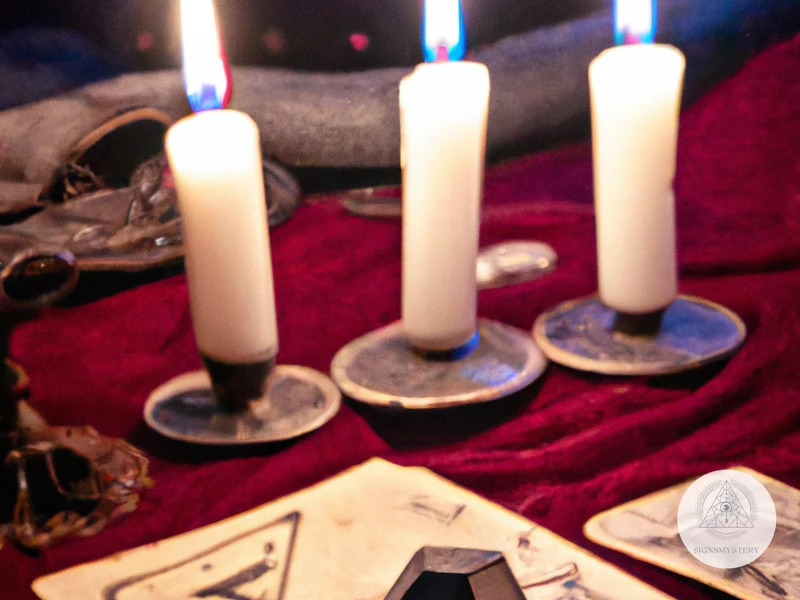
Throughout history, civilizations have sought ways to gain insight into the unknown and divine the future. Many cultures have created tools to aid in this practice, such as symbols, rituals, and divination tools. The use of divination tools is not limited to one time period or culture, as many practices have gained popularity in various regions of the world. Some of the most popular divination tools include Tarot cards, runes, I Ching, and Lenormand Cards. Each of these tools has a unique history and method of use, making them fascinating to both enthusiasts and skeptics alike. In the following sections, we will explore the origins and evolution of these ancient divination tools.
Tarot Cards
Tarot cards are one of the most well-known types of divination tools, consisting of 78 cards that are typically divided into the Major Arcana (22 cards representing major life events and archetypes) and Minor Arcana (56 cards representing everyday life events). Tarot cards have been used for centuries for guidance, introspection, and spiritual development.
The origins of Tarot cards are somewhat of a mystery, but they are widely believed to have originated in Italy in the early 15th century as a type of playing card game. It wasn’t until the late 18th century that Tarot cards began to be used for divination purposes, thanks to a Frenchman named Jean-Baptiste Alliette, who published a book called “Etteilla, ou manière de se récréer avec un jeu de cartes” (Etteilla, or How to Entertain Yourself with a Deck of Cards) under the pseudonym Etteilla.
The symbolism in Tarot cards is rich and complex, drawing on a range of spiritual and philosophical traditions. One of the most well-known decks is the Rider-Waite Deck, created in 1909 by artist Pamela Colman Smith and popularized by Arthur Edward Waite. This deck features highly detailed illustrations that incorporate elements of astrology, numerology, and Kabbalah.
Other popular Tarot decks include the Crowley-Harris Thoth Deck, created by famed occultist Aleister Crowley and artist Lady Frieda Harris, which incorporates Crowley’s unique spiritual system of Thelema; and the Osho Zen Tarot, a non-traditional deck that draws on Zen Buddhism and features abstract, minimalist illustrations.
While Tarot cards can be intimidating for beginners, there are many resources available for learning how to interpret them effectively. Many beginners start with simpler Oracle Card Decks to gain experience in divination and self-discovery before moving on to the complexity of the Tarot. With practice and dedication, Tarot cards can be a powerful tool for gaining insight and guidance in your life.
Runes
Runes are ancient Germanic symbols used for divination and communication dating back to the 1st century AD. The word “rune” means “secret” or “mystery” and the symbols were believed to hold magical powers. The symbols were etched onto stones, wood, or bone and then drawn or cast to interpret messages from the spiritual realm.
The most common runes included:
| Runes | Meaning |
|---|---|
| Fehu | Wealth and success |
| Ansuz | Inspiration and communication |
| Raido | Journey and movement |
| Kenaz | Creativity and knowledge |
| Gebo | Gifts and partnerships |
| Wunjo | Joy and harmony |
Rune casting originally involved placing all the symbols into a bag and drawing them out. Similar to tarot and other divination tools, the positioning and orientation of the rune had a significant impact on the meaning. As with all divination tools, the interpretation of the runes depended heavily on the intuition and expertise of the diviner.
Today, rune sets come in various materials and can be purchased online or in metaphysical shops. The modern use of runes for divination has grown in popularity in recent years, and many books and guides are available to aid interpretation.
Using runes for divination can help one connect with their intuition and internal wisdom to gain insight and make decisions. It is also a great tool for personal growth and discovering one’s inner potential. Incorporating oracle card interpretation or exploring oracle deck symbolism alongside runes can improve readings and deepen understanding.
I Ching
| Traditional I Ching | Oracle Card Interpretation |
|---|---|
| Hexagrams are created by throwing three coins six times | Hexagrams or other symbols associated with the I Ching may be included in Oracle Card decks to provide deeper meanings and interpretations in readings. |
| Each hexagram has its own meaning that is interpreted through the guidance of a book of interpretations | Oracle Card readings are interpretive and based on intuitive insights and guidance from the deck |
| Originally used mostly for divination | Oracle Card decks can be used for divination, but also as a spiritual and philosophical guide. |
| Influenced many other forms of divination and spiritual practices, including Taoism and acupuncture | Oracle Cards draw upon many different spiritual and philosophical practices to create a unique experience for each user. |
Lenormand Cards
Lenormand Cards are a type of oracle card deck that have a rich history dating back to the 18th century. These cards are named after Marie-Anne Adelaide Lenormand, a French fortune-teller who famously read for Napoleon Bonaparte and Josephine de Beauharnais.
There are 36 cards in a Lenormand deck, each with its own unique symbol and meaning. The cards are smaller in size than traditional Tarot cards, and the imagery is simplified yet detailed. The cards are often interpreted in pairs or groups, with combinations of cards creating new meanings and messages.
The symbolism of Lenormand Cards is deeply rooted in European culture, with many of the cards representing everyday objects and situations. For example, the Rider card can represent a messenger or news, while the Tree card can symbolize health and vitality. The Coffin card can denote endings and transformation, while the Stork represents change and new beginnings.
Unlike Tarot cards, Lenormand Cards are less focused on spiritual or esoteric themes, and more on everyday events and situations. As such, they are often used for practical divination and advice-giving.
In recent years, Lenormand Cards have experienced a resurgence in popularity, with modern decks featuring updated imagery and interpretations. There are many resources available for learning Lenormand Card reading, including online courses, books, and workshops.
If you are interested in learning more about Lenormand Cards and their interpretation, there are many resources available to help you get started. Whether you are a seasoned oracle card reader or a beginner, Lenormand Cards offer a unique and insightful perspective on everyday life events, and can be a valuable tool for gaining clarity and guidance.
19th and 20th Century Decks
As divination practices grew in popularity during the 19th and 20th centuries, so did the creation of new oracle card decks. Many of these decks drew inspiration from ancient divination tools and combined them with new symbolism and interpretations. These decks were created by individuals who sought to explore the depths of the human psyche and provide insight and guidance for those seeking it. While some of these decks have faded into obscurity, others have become staples in the world of divination. The history and evolution of these 19th and 20th-century oracle card decks provide a fascinating look at the development of divination practices and their symbolism. Through studying the symbolism and interpretation of these decks, one can gain a deeper understanding of the human experience and the mysteries of the universe.
The Oracle of Delphi
In ancient Greece, the Oracle of Delphi was a revered source of divination. The Oracle was believed to be able to communicate with Apollo, the god of music, poetry, and prophecy. Delphi was a pilgrimage site for people seeking answers to their questions about the future. The Oracle of Delphi was famous for its cryptic responses, and people were often left to interpret the answers themselves.
One of the ways the Oracle communicated was through the use of oracle bones. The bones were typically ox scapulae or turtle plastrons. The diviner would inscribe a question on the bone or plastron, and then heat it until it cracked. The diviner would then interpret the pattern of the cracks to provide an answer.
| Date Created | Country of Origin | Key Features |
|---|---|---|
| 8th century BC | Greece | Uses oracle bones for divination |
The Oracle of Delphi was also known for using other forms of divination, including the interpretation of dreams and the observation of natural phenomena, such as the flight patterns of birds. The Oracle’s messages were often open to interpretation, allowing the questioner to find their own meaning in the response.
Today, the Oracle of Delphi continues to inspire divination practices, including the use of oracle cards. Oracle cards, like the bones used by the Oracle of Delphi, provide guidance and insight into the future. The interpretation of the cards is left up to the individual, allowing for a personalized experience. Learning tarot card interpretation and understanding oracle deck symbolism can assist in reading these cards.
The Sibyls
The Sibyls were prophetesses from ancient Greece and Rome, who were believed to possess extraordinary supernatural powers. These women were consulted by rulers and ordinary people alike, seeking answers to important questions about the future.
The Sibyls’ prophecies were often cryptic and required interpretation, similar to oracle card readings today.
There were several Sibyls, each associated with a different location and known for their unique abilities. One of the most famous Sibyls was the Cumaean Sibyl, who resided in a cave near Naples. It was believed that she could foretell the future for several centuries ahead.
The prophecies of the Sibyls were often recorded in books, which were highly prized and consulted by many. One such book was the Sibylline Books, a collection of oracular utterances that were consulted by Roman leaders during times of crisis.
The Sibyls were also depicted in art, such as the famous Sistine Chapel fresco by Michelangelo. In this painting, the Cumaean Sibyl is portrayed holding a book and gazing into the distance, as if receiving divine inspiration.
Today, the Sibyls continue to inspire artists and spiritual seekers. Their legacy can be seen in many modern oracle decks, which often draw on the rich symbolism and mythology of ancient Greece and Rome. Understanding the historical context of the Sibyls can deepen our appreciation for the oracle cards we use today, helping us to unlock their hidden meanings and insights.
To learn more about oracle card interpretation, check out our guide to oracle card interpretation. For a deeper look at oracle deck symbolism, explore our article on oracle deck symbolism.
The Fortune-Telling Cards of Antoine Court de Gébelin
In the late 18th century, Antoine Court de Gébelin became fascinated with the mysterious symbolism of the Tarot and its potential for divination. He believed that the cards held the secrets of Egyptian gods and mythology that had been passed down through the ages.
In 1781, he published a book called “Le Monde primitif, analysé et comparé avec le monde moderne” (The Primitive World, Analyzed and Compared to the Modern World), in which he included his interpretations of the Tarot cards. He claimed that the Tarot was a representation of the lost wisdom of the ancient Egyptians, which had been preserved in the form of symbols on the cards.
To bring his vision to life, Court de Gébelin commissioned artist Claude Burdel to create a set of Tarot cards that would accurately reflect his interpretations. The resulting deck became known as the Fortune-Telling Cards of Antoine Court de Gébelin.
The deck consisted of 78 cards, divided into the Major Arcana and the Minor Arcana. The Major Arcana featured illustrations of Egyptian gods and goddesses, while the Minor Arcana depicted scenes from everyday life.
Although Court de Gébelin’s interpretations of the Tarot were widely criticized at the time, his influence cannot be overstated. His work paved the way for many other Tarot decks that followed, and his belief in the Tarot’s potential for divination laid the groundwork for the modern practice of Tarot reading.
The Marseille Deck
The Marseille Deck is one of the oldest and most popular decks of tarot cards. It was first printed in the city of Marseille, France, in the 17th century. The deck features brightly colored arcana cards that are designed to help users unlock their inner wisdom and intuition.
The Marseille Deck consists of 78 cards, with 22 of those cards being major arcana cards and the other 56 being minor arcana cards. The major arcana cards feature powerful figures, such as the Fool, the Magician, the High Priestess, and the Emperor. The minor arcana cards represent everyday events and situations, such as love, money, and work.
One of the most unique features of the Marseille Deck is the way that the cards are illustrated. The imagery on each card is simple and straightforward, with no extraneous details or distractions. This allows users to focus on the core meaning of each card without getting lost in the details.
The Marseille Deck has been used for centuries as a tool for divination and self-discovery. Its straightforward imagery and powerful symbolism have resonated with people from all walks of life. Whether you are a seasoned tarot reader or a newcomer to the world of divination, the Marseille Deck is a powerful tool that can help you unlock your inner wisdom and intuition.
Here is a table outlining the basic structure of the Marseille Deck:
| Card Type | Number of Cards | Meaning |
| Major Arcana | 22 | Powerful archetypal figures that represent major life themes and lessons |
| Minor Arcana | 56 | Represent everyday events and situations, such as love, money, and work |
The Marseille Deck is a powerful and enduring tool that has helped countless people unlock their inner wisdom and intuition. Whether you are a seasoned tarot reader or a newcomer to the world of divination, the Marseille Deck is a valuable addition to any spiritual tool kit.
The Rider-Waite Deck
One of the most popular and enduring tarot decks of all time is the Rider-Waite deck. This deck was first published in 1909 and was created by artist Pamela Colman Smith and scholar A. E. Waite.
Symbolism: The Rider-Waite deck is known for its detailed and colorful illustrations, which are rich in symbolism. The illustrations depict scenes from everyday life, mythical stories, and spiritual teachings. Each card has a specific meaning and purpose, and the images are designed to evoke certain emotions and feelings.
Influence: The Rider-Waite deck has had a significant impact on the world of divination and tarot reading, and it has inspired numerous other decks and interpretations. It is often used as a reference point for other tarot readers and has helped to establish a standard set of symbols and meanings for the cards.
Controversy: Despite its popularity, the Rider-Waite deck has also been the subject of some controversy. Some critics have argued that it is too focused on Judeo-Christian symbolism and that it lacks the broader cultural and spiritual diversity that can be found in other tarot decks. Others have claimed that the images are too simplistic and lack the depth and complexity necessary for truly meaningful divination.
Legacy: Despite these criticisms, the Rider-Waite deck remains one of the most beloved and widely used tarot decks in the world. Its legacy is evident in the countless other decks that have been inspired by it, as well as the numerous books and resources that have been developed to help people learn and use the tarot. Whether you are a seasoned tarot reader or just starting out, the Rider-Waite deck is a fantastic tool for exploring the mysteries of the universe and gaining insights into your own life.
The Crowley-Harris Thoth Deck
The Crowley-Harris Thoth Deck is a highly revered and controversial deck of oracle cards that was created in the early twentieth century by Aleister Crowley, a British occultist, and Lady Frieda Harris, a talented artist. The deck is known for its intricate and cryptic symbolism, which draws on a range of esoteric disciplines and mythological systems.
Some key features of the Crowley-Harris Thoth Deck include:
The Major Arcana: This set of 22 cards represents archetypal forces and universal themes, such as The Fool, The Magician, The Empress, and The Tower. Each card is richly detailed and layered with meaning, conveying a sense of deep wisdom and cosmic significance.
The Minor Arcana: This set of 56 cards is divided into four suits: Swords, Cups, Wands, and Pentacles. Each suit is associated with a different element (Air, Water, Fire, and Earth) and represents a particular aspect of human experience, such as intellect, emotion, creativity, and material wealth.
The Court Cards: Each suit also contains four “court” cards, which typically represent people of different ages and genders who embody the qualities of the suit. For example, the King of Swords might represent a wise and intellectual mentor, while the Queen of Cups might embody emotional intelligence and sensitivity.
The Crowley-Harris Thoth Deck
Subscribe to Our Newsletter
Sign up to receive the latest news and updates.
Regardless of one’s opinion of the deck, it is undeniable that the Crowley-Harris Thoth Deck has had a significant impact on the world of oracle cards and on the broader field of esoteric studies. Many modern decks draw on the Thoth Deck for inspiration or incorporate some of its key symbols and archetypes.
The Osho Zen Tarot
The Osho Zen Tarot is a very different type of tarot deck from the traditional ones. Created by Ma Deva Padma, a disciple of the Indian guru Osho, this deck was designed to reflect the teachings of Osho, a spiritual leader who emphasized the importance of living in the present moment.
Unique Design: This deck features vibrant, modern artwork that is vastly different from the traditional tarot deck designs. The cards themselves are larger, and each card has a single word at the bottom, which is meant to provide a quick and easy interpretation.
Breaking the Mold: The Osho Zen Tarot deck breaks many of the traditional tarot conventions, such as having no Major or Minor Arcana, and the cards aren’t necessarily categorized as suits like in a traditional tarot deck. Instead, the cards are named after natural elements such as Fire, Water, and Earth.
Inner Growth: The Osho Zen Tarot isn’t as focused on predicting the future as it is on encouraging inner growth and self-awareness. The deck is meant to help identify the significant areas of one’s life and to encourage developing a deeper understanding of oneself. The cards don’t provide definitive answers but rather provoke thoughts, forcing you to consider things about yourself that you might not have otherwise.
Zen Teachings: The deck is infused with Zen teachings, which emphasize the importance of living in the present moment and viewing life with detachment. This deck’s messages promote mindfulness, non-judgmental awareness, and finding a balance in life.
Conclusion: The Osho Zen Tarot deck is not for everyone, but for those who want to approach tarot in a new way, it is a refreshing, modern option. It helps to shift the focus from predicting the future to introspection and self-awareness. If you’re looking for a tarot deck that gives you insight into yourself, how you approach life, and encourages personal growth, the Osho Zen Tarot may be the perfect fit.
Modern Oracle Cards
As society has evolved, so too have our tools for divination. While Tarot cards and Runes have been used for centuries, a new era of divination has emerged with modern Oracle Cards. These decks utilize beautiful imagery and concise messages to provide insight and guidance. From the Angel Cards of Doreen Virtue to the mystical Moon Deck, each oracle deck has its own unique energy and purpose. Let’s explore some of the most popular and intriguing modern oracle decks available today.
The Angel Cards of Doreen Virtue
One of the most popular and well-known modern oracle card decks is ‘The Angel Cards’ created by Doreen Virtue. This deck includes 44 cards featuring angels and archangels, each with their own unique message and guidance for the seeker.
The Angel Cards are known for their gentle and uplifting energy, making them a favorite among those who seek guidance and comfort from the divine. Each card offers a message of hope, love, and encouragement, reminding us that we are never truly alone.
Many people use these cards for daily guidance or in times of need, and believe that the angels are always there to help and guide us on our journey. The deck also includes a guidebook written by Virtue, which offers insight into the meaning of each card and how to use them effectively.
One of the unique features of the Angel Cards is the inclusion of archangels, such as Archangel Michael, Gabriel, and Raphael, who are believed to be powerful spiritual beings that can assist in various areas of our lives. Each archangel has their own area of expertise, such as protection, communication, and healing, and can be called upon for assistance and guidance.
The Angel Cards have become a popular and beloved tool for those seeking spiritual guidance and support. Their messages of love and encouragement offer hope and inspiration to all who use them.
The Power of Now Cards
“The Power of Now Cards” is a popular oracle card deck that draws its inspiration from the teachings of spiritual teacher Eckhart Tolle. The deck features 50 cards, each with a unique message that encourages individuals to stay present and mindful in the moment.
One of the standout features of “The Power of Now Cards” is its minimalist design. The cards are all black and white, with a simple image and word or phrase on each card. This simplicity encourages users to focus on the message of the card without becoming distracted by elaborate artwork or design elements.
The messages on the cards encourage individuals to connect with their inner selves and the present moment, and offer guidance for navigating life’s challenges. Some examples of card messages include “Acceptance,” “Surrender to What Is,” and “Embrace Your True Nature.”
The deck can be used for daily guidance, meditation, or as a tool for personal growth and reflection. The messages on the cards are meant to be interpreted subjectively, with users encouraged to reflect on how each message applies to their own life and experiences.
Overall, “The Power of Now Cards” offers a simple yet profound tool for mindfulness and personal growth, drawing on the wisdom of Eckhart Tolle’s teachings for inspiration.
The Wild Unknown Deck
The Wild Unknown Deck is a beautiful and mystical deck that has captured the attention of many card readers. This deck was created by artist Kim Krans in 2012 and quickly became popular due to its unique illustrations and symbolism.
Illustrations: The Wild Unknown Deck features beautiful and intricate black and white illustrations. The images are simple yet detailed and often include animals, plants, and natural elements. Each card has its own symbolism that can be interpreted in various ways.
Card Meanings: The meanings of the cards in The Wild Unknown Deck are somewhat open to interpretation. The deck does not follow traditional tarot meanings, but rather encourages the reader to connect with their intuition and inner wisdom.
Deck Structure: The Wild Unknown Deck consists of 78 cards, divided into two categories – the Major Arcana and Minor Arcana. The Major Arcana consists of 22 cards, each representing a major life lesson or theme. The Minor Arcana consists of 56 cards, divided into four suits – Wands, Swords, Cups, and Pentacles – each with its own set of meanings.
Deck Packaging: The Wild Unknown Deck comes in a sturdy cardboard box with a beautiful black and white design. The cards themselves are printed on high-quality cardstock with a matte finish, making them easy to shuffle and handle.
Popularity: The Wild Unknown Deck has gained a large following among spiritual seekers and tarot enthusiasts. The deck’s unique artwork and non-traditional approach make it a popular choice for those who want to connect with their intuition and receive guidance from the cards.
The Wild Unknown Deck is a beautiful and powerful tool for self-discovery and guidance. Its unique illustrations and open-ended meanings make it a great choice for anyone looking to explore the world of oracle cards.
The Mystic Mondays Deck
The Mystic Mondays deck is a relatively new deck that was created by Grace Duong in 2017. What sets this deck apart from others is its modern and minimalist design. The cards feature bold and vibrant colors with simple line drawings. The deck also incorporates cosmic and spiritual symbols, making it popular among those who are interested in astrology and mysticism.
One of the standout features of the Mystic Mondays deck is the accompanying guidebook. The guidebook not only provides a detailed description of each card but also offers affirmations and insights to help the reader connect with their intuition and inner wisdom. The guidebook also includes spreads for different types of readings and tips for interpreting the cards’ meanings.
The Mystic Mondays deck has resonated with many individuals who are drawn to its contemporary look and its empowering messages. The deck’s tagline, “modern tarot for the mystic mind,” speaks to its unique approach to divination.
The Mystic Mondays deck has been praised for its inclusivity. The deck features a diverse range of individuals on the cards, representing different races, genders, sexual orientations, and body types. This makes the deck more accessible and relatable to a wider audience, which is important in the world of divination.
The Mystic Mondays deck is a fresh and inspiring addition to the world of oracle cards. Its modern and minimalist design, inclusive representation, and empowering guidebook make it a popular choice for those seeking guidance and insight.
The Moon Deck
The Moon Deck is a relatively new oracle deck that was first published in 2016 by Aarona Ganesan and Andrea Keh. This deck is heavily influenced by yoga and spirituality, and it features beautiful and minimalist illustrations that draw upon natural elements and the power of the moon. The Moon Deck includes 44 cards that are divided into eight different elemental themes, with each theme focusing on a different aspect of life and personal growth.
One of the standout features of The Moon Deck is the inclusion of a guidebook that provides detailed meanings and interpretations for each of the cards. The guidebook is written in a thoughtful and introspective style, with a focus on mindfulness and self-reflection. Each card features a mantra, or short phrase, that is meant to inspire and empower the reader.
Some of the elemental themes included in The Moon Deck are Strength, Heart, Ground, Trust, and Vision. Each of these themes is represented by a handful of cards that feature beautiful, hand-drawn illustrations. The Strength theme, for example, includes the card “Transform,” which depicts a butterfly emerging from a cocoon. This card is designed to inspire transformation and personal growth.
The Moon Deck is a powerful tool for those looking to connect with their inner selves and navigate the ups and downs of life. Its focus on mindfulness and self-reflection, paired with beautiful artwork and powerful affirmations, make it a must-have for anyone interested in yoga, spirituality, or personal growth.
| Unique Features | Elemental Themes | Illustration Style |
|---|---|---|
| Inclusion of guidebook with detailed meanings for each card | Strength | Hand-drawn illustrations of natural elements and the power of the moon |
| Focus on mindfulness and self-reflection | Heart | Minimalist design |
| Each card features a mantra to inspire and empower the reader | Ground | Beautiful use of color and negative space |
| Trust | ||
| Vision |
Conclusion
After tracing the history and evolution of popular oracle card decks, it is clear that these divination tools have held a significant place in various cultures and traditions throughout the world. From ancient times to the modern-day, people have sought guidance and insight through the use of divination tools like tarot cards, runes, and Lenormand cards.
Many of the decks that we use today have evolved from their ancient counterparts, undergoing changes and transformations over the years. The decks of the 19th and 20th century have been particularly influential, including decks such as The Oracle of Delphi, The Sibyls, and The Crowley-Harris Thoth Deck.
In recent times, oracle card decks have continued to grow in popularity, with countless new decks being created to suit every taste and preference. From the Angel Cards of Doreen Virtue to the Wild Unknown Deck, there are now endless options available for those seeking guidance from these powerful tools.
While many people remain skeptical about the accuracy and usefulness of divination tools, their enduring popularity suggests that they will continue to play a significant role in human culture and spirituality for many years to come.
Overall, the history and evolution of oracle card decks demonstrate the enduring human desire to seek meaning and guidance in the world around us. Whether used for divination or simple introspection, these powerful tools offer a valuable perspective on our lives and the world we live in.
Frequently Asked Questions
What is an oracle card deck?
An oracle card deck is a set of cards used for divination or fortune-telling purposes. They typically feature symbols, images, or words that can be interpreted to provide guidance, insight, or inspiration.
How old are divination tools?
Divination tools are ancient and have been used for millennia in different cultures and traditions around the world.
What is the most well-known divination tool?
The most well-known divination tool is probably the tarot cards, which have gained popularity in recent times as a means of seeking guidance and insight.
What are runes?
Runes are a set of ancient Germanic symbols that were used for writing and divination purposes.
What is the I Ching?
The I Ching is an ancient Chinese divination tool that involves the interpretation of hexagrams based on the insertion of yarrow sticks or coins.
Who was Lenormand?
Mademoiselle Lenormand was a famous French fortune-teller who lived during the 18th century and became known for her detailed readings and predictions using a set of playing cards that now bears her name.
What is the difference between tarot cards and oracle cards?
Tarot cards have a specific structure and set of meanings that are followed by most readers, while oracle cards can vary widely in terms of imagery, symbolism, and interpretation.
Who created the Rider-Waite deck?
The Rider-Waite tarot deck, also known as the Rider-Waite-Smith or Waite-Smith deck, was created by British occultist Arthur Edward Waite and illustrated by American artist Pamela Colman Smith.
What is the Osho Zen Tarot?
The Osho Zen Tarot is a non-traditional tarot deck that was inspired by the teachings of spiritual leader Osho and designed to offer a more contemporary and intuitive approach to divination.
What are the Angel Cards of Doreen Virtue?
The Angel Cards of Doreen Virtue are a popular set of oracle cards that feature angelic messages and affirmations intended to provide guidance, support, and inspiration.






